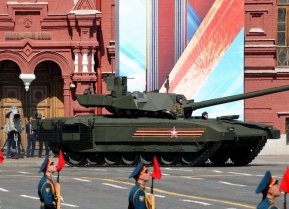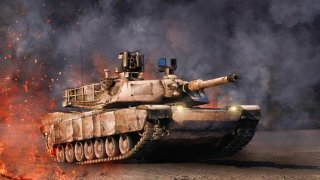The U.S. Army's M1 Abrams Tank: A Complete History of the Best Tank Ever
Over the platform’s nearly four decades in service, several variants hosting newer and more advanced capabilities have surfaced. Some experts consider the M1 Abrams tank the best tank ever to serve - to this day.
Earlier this year, the U.S. and its North Atlantic Treaty Organization (NATO) allies agreed to send dozens of modern tanks to aid Ukraine’s defensive efforts amidst Russia’s ongoing invasion. American-made M1 Abrams, German Leopard IIs, and British Challengers have all made their way to Kyiv in recent months in a massive blow to Moscow’s suffering offensive.
Despite the introduction and training of crew on these sophisticated main battle tanks (MBTs), they have not seen much action this winter season. Due to poor weather conditions, including mud, rain, and snow, Ukrainian troops have limited the number of small Bradley fighting vehicles and Abrams tanks they have been sending to the frontlines.
As Moscow has prepared for the delivery of these advanced MBTs, its own troops have built heavily fortified defensive lines. According to Russian state media outlets, miles of trenches and minefields will threaten Ukraine’s tank fleets once they are deployed.
Introducing the Abrams family of tanks:
Back in the 1960s, the U.S. Army worked alongside its West German counterparts to develop a joint tank design that was intended to replace both the American M60 MBT and the German Leopard I. Both nations desired a formidable tank that could go up against the Soviet Union’s T-62s. From greater firepower to improved protection measures, the resulting collaborative MBT was quite sophisticated on paper. Dubbed the MBT-70, the new tank was fitted with a hydropneumatics suspension, new 1,500 horsepower engines and a 152mm gun. Although the MBT-70 appeared to possess winning qualities, it also came with quite the hefty price tag. In fact, by the end of the decade, the estimated price per tank was roughly five times more than original estimates, causing the Department of Defense to nix the program.
The MBT-70 would lead to news ideas in directions in tank design. Ultimately, the U.S. Army would receive the M1 Abrams. Chrysler Defense (currently General Dynamics) designed this MBT as the service’s M60 Patton replacement. By the mid-1980s, a total of 3,273 Abrams tanks were produced.
This MBT platform featured several cutting-edge characteristics. In addition to being the first tank of its kind to sport Chobham armor, the Abrams was also armed with the license-built M68A1 version of the 105mm Royal Ordnance L7 gun. The Chobham composite armor consisted of a sophisticated material that made it challenging for enemy tanks to penetrate.
The new main gun, coupled with the tank's 1,500 horsepower turbine engine and advanced tracking systems, also set this platform over the edge.
The Abrams family of tanks has been deployed for decades
Over the platform’s nearly four decades in service, several variants hosting newer and more advanced capabilities have surfaced. Some experts consider the M1 Abrams tank the best tank ever to serve - to this day.
In 1990, the Army’s M1A2 tank was approved for production. While appearing very similar to its M1 predecessor, the new tank’s internal composition was radically redesigned to take advantage of growing technologies. Perhaps the most significant feature of the M1A2 sports is the Inter-Vehicle Information System. As detailed by Military.com, a tank’s unit commander can easily track the position and progress of subordinate elements automatically, while simultaneously identifying enemy positions.
The M1A2 SEPv2 tanks were introduced to service by the late 1990’s. Upgraded with greater armor protection, computer components, and other enhancements, these MBTs were a step up from their predecessors. In fact, this variant formed the backbone of the U.S. Army’s armored corps - as the military operated at least 900 M1A2 SepV2 MBTs.
The SEPv3 is the latest configuration of the tank, which is equipped with even more improvements. From forward-looking infrared to greater acquisition, identification and engagement, this variant is quite formidable.
What’s next for this line of MBTs?
Its successor, the SEPv4 Abrams model, was designed to sport even more capabilities than before. The new variant was intended to feature lethality improvements, including the new XM1147 Advanced Multi-Purpose round for the tank’s 120mm main gun. As detailed by the Drive, the latest variant was also expected to be incorporated with a Laser Warning Receiver system to enhance survivability by “altering the crew that targeting lasers associated with guided anti-tank missiles and other weapons are being aimed at them.”

While these features may sound great, the Army has decided to nix the SEPv4 variant altogether. According to the Army, the axing of this variant is necessary so that the service can allocate resources toward MBTs with increased mobility and survivability. Specifically, the Army wants a lighter-weight and more adaptable tank that can remain relevant for decades to come.

The ongoing war in Ukraine has proven that main battle tanks will continue to play significant roles in modern conflicts. Based on the MBT losses both Kyiv and Moscow have experienced over the last 600+ days of war, the U.S. Army’s drive for a top-of-the-line new tank variant is being prioritized. “The development of the M1E3 Abrams will include the best features of the M1A2 SEPv4 and will comply with the latest modular open systems architecture standards, allowing quicker technology upgrades and requiring fewer resources,” the service has detailed following this announcement.
Maya Carlin is an analyst with the Center for Security Policy and a former Anna Sobol Levy Fellow at IDC Herzliya in Israel. She has by-lines in many publications, including The National Interest, Jerusalem Post, and Times of Israel. You can follow her on Twitter: @MayaCarlin.
Main image is from Shutterstock. All other images are Creative Commons.


